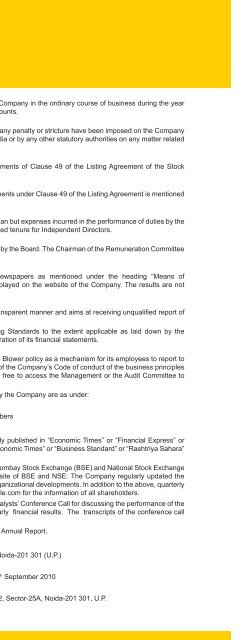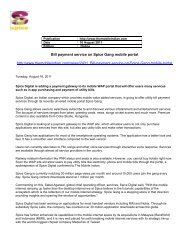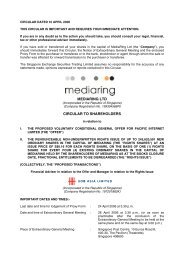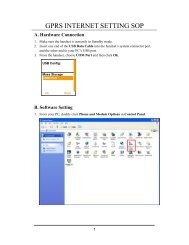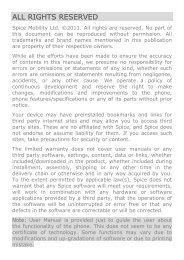You also want an ePaper? Increase the reach of your titles
YUMPU automatically turns print PDFs into web optimized ePapers that Google loves.
<strong>Spice</strong> <strong>Mobility</strong> Limited (formerly <strong>Spice</strong> Mobiles Limited)<br />
Schedule 24<br />
Notes to Accounts<br />
1. Nature of Operations<br />
The Company is primarily engaged in the trading and manufacturing of Mobile handset and accessories. During the year, the<br />
Company has set up a plant at its facility in Baddi, in the state of Himachal Pradesh, for manufacturing of mobile handsets.<br />
2. Statement of Signifi cant Accounting Policies<br />
a) Basis of Preparation<br />
The fi nancial statements have been prepared to comply in all material respects with the Accounting Standards notifi ed by<br />
Companies Accounting Standard Rules, 2006 (as amended), and the relevant provisions of the Companies Act, 1956. The<br />
fi nancial statements have been prepared under the historical cost convention on an accrual basis. The accounting policies<br />
have been consistently applied by the Company, and except for the change in accounting policy discussed more fully below,<br />
are consistent with those used in the previous year.<br />
b) Change in Accounting Policy<br />
During the year with effect from January 8, 2010, the Company has implemented SAP system under ERP Platform. Accordingly,<br />
the Company has changed its method of valuation of inventory of traded goods, raw materials, service components and spares<br />
from monthly weighted average method to transaction moving weighted average method. The impact of change has not been<br />
ascertained. However the same is not likely to have a material impact on the profi t of the Company for the current year.<br />
c) Use of estimates<br />
The preparation of fi nancial statements in conformity with generally accepted accounting principles requires management<br />
to make estimates and assumptions that effect the reported amounts of assets and liabilities and disclosure of contingent<br />
liabilities at the date of the fi nancial statements and the results of operations during the reporting period end. Although these<br />
estimates are based upon management’s best knowledge of current events and actions, actual results could differ from these<br />
estimates.<br />
d) Fixed Assets<br />
Fixed assets are stated at cost, less accumulated depreciation/amortisation and impairment losses, if any. Cost comprises<br />
the purchase price and any attributable cost of bringing the asset to its working condition for its intended use. Borrowing costs<br />
relating to acquisition of fi xed assets which takes substantial period of time to get ready for its intended use are also included<br />
to the extent they relate to the period till such assets are ready to be put to use.<br />
e) Depreciation / Amortisation<br />
i) Depreciation is provided using the straight line method as per the useful lives of the assets estimated by the management,<br />
or at the rates prescribed under Schedule XIV of the Companies Act, 1956, whichever is higher. In the following cases,<br />
the depreciation rates are higher than the corresponding rates prescribed in Schedule XIV of the Companies Act, 1956 :<br />
Rates (SLM) Sch XIV Rates (SLM)<br />
Technical equipments (included in Plant and Machinery) 10.00% 4.75%<br />
Building at Baddi in the State of Himachal Pradesh 7.27% 3.34%<br />
f)<br />
ii) Leasehold improvements are depreciated over the primary lease period or its useful life whichever is lower.<br />
iii) All individual assets costing Rs. 5,000 or less are depreciated in full in the year of addition.<br />
iv) Intangible Assets (Software’s) are amortised over their useful lives not exceeding six years.<br />
Impairment<br />
The carrying amounts of assets are reviewed at each balance sheet date if there is any indication of impairment based on<br />
internal/external factors. An impairment loss is recognized wherever the carrying amount of an asset exceeds its recoverable<br />
amount. The recoverable amount is the greater of the asset’s net selling price and value in use. In assessing value in use, the<br />
estimated future cash fl ows are discounted to their present value at the weighted average cost of capital.<br />
g) Leases<br />
Where the Company is the lessee<br />
Leases, where the lessor effectively retains substantially all risks and benefi ts of ownership of the leased item, are classifi ed<br />
as operating leases. Operating lease payments are recognized as an expense in the Profi t and Loss Account on a straight–<br />
line basis over the lease term.<br />
37


